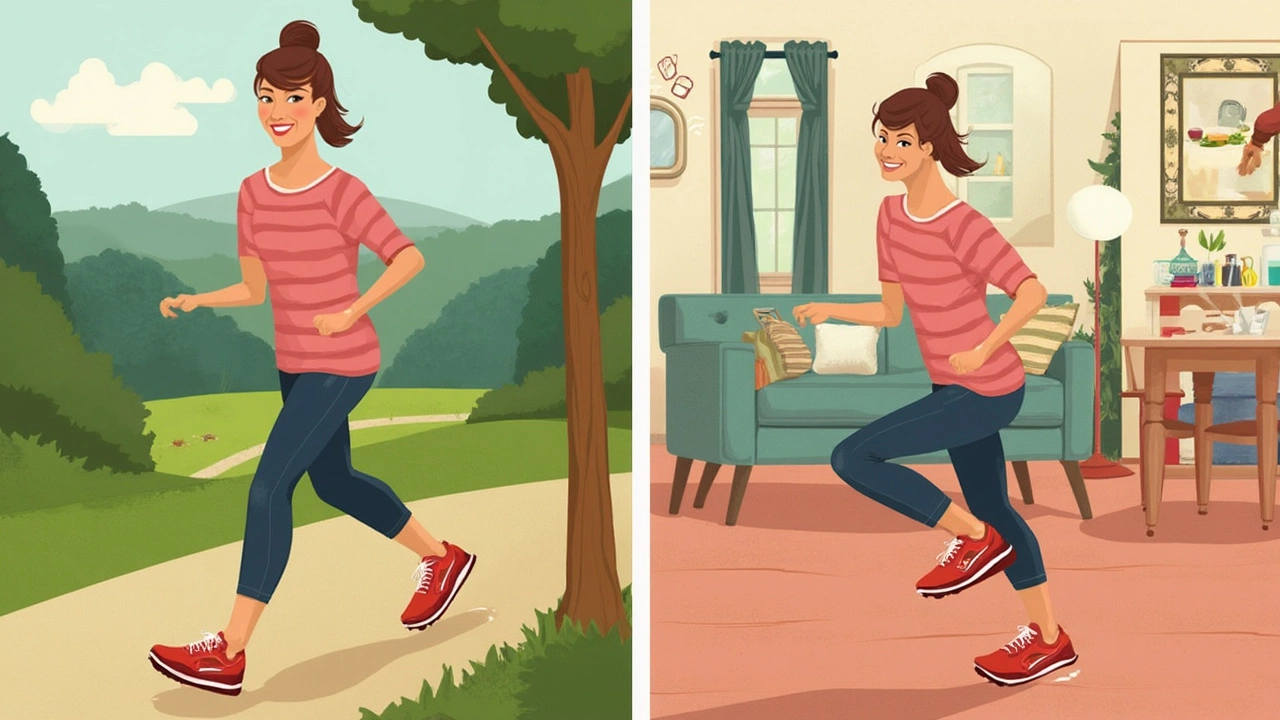
Walking is one of those things everyone does, but does it actually count as strength training? A lot of people swear by their daily walks—great for clearing your head and good for your heart. But if your main goal is to get stronger, walking might not be the golden ticket.
Here’s the real deal: strength training usually means you’re making your muscles work harder than they’re used to. This can be with weights, resistance bands, or even your own body weight. Walking uses your muscles, that’s true—but it doesn’t push them like a squat or a pushup does.
But that doesn’t mean your steps are wasted! Walking still wakes up your legs, especially your calves and glutes. Ever felt a bit sore after a long hike? That’s your muscles telling you they put in the work, just on a lighter level. Still, there’s a clear line between walking and what most trainers call strength training.
People throw around the term strength training all the time, but what does it actually mean? In the fitness world, it’s any activity that makes your muscles work harder than they do in everyday life. The goal: challenge your muscles so they get stronger over time. This stress can come from your body weight, free weights, resistance bands, or even machines at the gym. The key is resistance—if you’re not adding some kind of load, it probably isn’t real strength training.
Let’s talk about the basics. Classic strength training moves are things like squats, push-ups, lunges, and deadlifts. These movements hit major muscle groups and need your muscles to push against serious resistance. You can use dumbbells, kettlebells, or just your own body weight if you’re doing something tough, like a push-up or a pull-up.
Here’s a look at what counts versus what doesn’t, just so there’s no confusion:
| Activity | Strength Training? |
|---|---|
| Walking | No |
| Squats | Yes |
| Running | No |
| Push-Ups | Yes |
| Yoga (power style) | Sometimes |
| Biking | No |
| Pull-Ups | Yes |
The main difference? If you aren’t putting your muscles under some kind of real, added tension, you’re not really getting the muscle-building effect most folks mean when they say strength training. So, while you might break a sweat walking up a hill, it’s just not in the same league as lifting or big, tough bodyweight moves for building strength.
Walking mainly works the muscles in your lower body. Every step fires up your calves, hamstrings, quadriceps, and glutes. These are your pushing, pulling, and stabilizing muscles that keep you moving forward and stop you from toppling over. If you walk at a good pace or tackle some hills, your core also jumps in, tightening up to help balance you and protect your back.
Unlike classic strength training, which is all about challenging your muscles with tough resistance, walking gives your muscles a gentler, steady job. It doesn’t overload them but instead keeps them moving for longer periods. That’s called endurance—think of it like charging your phone slowly, instead of quickly plugging in for a power boost.
Now, some people wonder if walking actually changes muscle size or strength. Truth is, regular walking helps your muscles stay toned and stops them from getting weak, especially if you haven’t been active. After an hour-long walk, you might feel a little tightness in your legs—that’s your muscles telling you they got a workout, just not a heavy-duty one.
Check out the muscle groups activated most during walking:
Fun fact: According to a study out of the University of Michigan, older adults who walk regularly can maintain up to 80% more muscle function in their legs than those who don't. So, while walking won't bulk you up, it totally helps keep your muscles working and healthy, especially if you’re not into gym stuff.
This is where things get a little tricky. Walking does use your muscles—especially your calves, hamstrings, quads, and glutes. So, yes, it can help these muscles stay active and prevent them from getting weaker. But here’s the catch: walking is considered a low-resistance activity. That means you’re not really pushing your muscles hard enough to get what trainers call “progressive overload,” which is key for gaining serious strength.
If you’re just starting out, or if you’ve been inactive for a while, walking can actually help you gain some basic muscle tone. There’s even research showing older adults, especially those recovering from injuries or very sedentary, can see a small boost in muscle mass just from regular walking. For most healthy adults, though, your muscles adapt super fast—they get used to your regular route, and before long, you’re not really challenging them anymore.
| Walking Level | Muscle Challenge | Strength Gain Potential |
|---|---|---|
| Short, flat walks | Low | Minimal |
| Long/hilly walks | Moderate | Some for beginners |
| Weighted walks (like a backpack) | Higher | Better |
If you want to squeeze a little more strength out of your regular walking, there are ways to up the challenge. Add hills, stairs, or a weighted backpack and you’ll feel the burn. But traditional strength training—like lifting weights or doing resistance bands—still works your muscles way harder. So, while walking is awesome for general movement and a little bit of muscle maintenance, most people won’t build lots of strength unless they add extra resistance or variety.

If you love walking but want to get a bit more out of it, you’re not alone. You can actually tweak your walks to sneak in a bit more strength training. Here’s how to take your basic stroll up a notch and work more muscle with every step:
Fun fact: A study from the American Council on Exercise found that walking at just a 5% incline on a treadmill can boost calorie burn by up to 50% compared to level walking, and puts more load on your leg muscles. Check out this quick comparison:
| Type of Walk | Muscle Activation | Calories Burned (30 min, 150 lb adult) |
|---|---|---|
| Flat | Low | 95 |
| Incline (5%) | Medium | 140 |
| Incline+Weights | High | 150+ |
Last tip: Mix things up! Combine these tweaks so you don’t get bored and your muscles keep guessing. The more you switch it up, the more you’ll get from your fitness routine—without losing the joy of a good walk.
Walking checks a lot of boxes for health—it gets your heart rate up, works your legs, and helps clear your mind. But here’s the truth: if you’re after true strength training benefits, walking won’t get you all the way there. Real muscle growth and serious strength gains come from challenging your muscles way beyond what they’re used to, which means adding resistance or extra weight.
Physical therapists and trainers agree that as your body adapts, casual walking just won’t provide that extra push. If you’ve been walking for a few weeks or months and it’s starting to feel easy, your muscles probably aren’t growing any stronger at that point—they’re just maintaining. Your bones also need more challenge to get denser, which is something regular walking won’t offer after you’re used to it.
For anyone looking to prevent age-related muscle loss (called sarcopenia) or boost everyday strength, you’ll need to add dedicated resistance work. Here’s what signs to look for that it’s time to step up your routine:
Let’s check out some numbers that show where walking sits compared to classic strength training routines:
| Activity | Average Calories Burned per Hour* | Muscle Groups Worked | Main Benefit |
|---|---|---|---|
| Brisk Walking | 200–300 | Legs, Glutes (lightly) | Cardio, Endurance |
| Strength Training (weights/bodyweight) | 250–400 | Full body (depends on exercise) | Muscle growth, Strength |
*Based on a 155 lb person, data from Harvard Health Publishing.
The bottom line? If you rely only on walking for exercise, you might miss out on all the perks strength training brings, like stronger bones, more muscle, and better everyday function. Mixing things up is your ticket to a stronger, healthier body.
Mixing walking with actual strength training is a smart way to get a well-rounded routine. The reality is, walking takes care of your heart and gets your steps up, but your body also craves real muscle work for things like bone health, balance, and burning more calories at rest.
If you’re already walking most days, adding two or three strength sessions each week is a solid move. You can keep things simple by using your own body weight—think squats, lunges, pushups, or planks. A lot of people like to split up their days—walk some days, do dedicated strength workouts on others. But honestly, blending both in one session can keep things interesting and save you time.
Here’s an easy combo workout you can try outside or at the gym:
If you do this circuit a couple of times, you’re getting both cardio and muscle work. This boosts your metabolism more than just steady walking alone.
Resistance bands or small dumbbells are easy to carry and help add some challenge. If you only have time for one workout, try stacking your strength training at the end of your walk, when your muscles are already warmed up.
Researchers have found that people who mix cardio with strength moves see better blood sugar control, improved mood, and keep muscle as they age. Combining both also reduces boredom—let’s be real, sometimes straight walking gets dull.
Here’s a quick comparison of benefits when you mix both approaches:
| Workout Type | Calories Burned Per Hour | Muscle Groups Targeted |
|---|---|---|
| Walking (brisk pace) | 250-350 | Legs, Glutes |
| Strength Training | 200-400 | Full Body (depends on exercises) |
| Combined Session | 300-500 | Full Body + Cardio |
If you want the best of both worlds—heart health and muscle—you can’t beat combining walking with strength training. It’s flexible, doesn’t have to cost a dime, and helps keep you fit long-term.